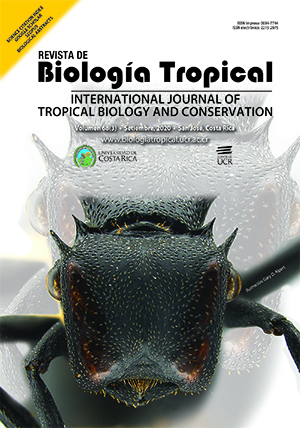Resumen
RESUMEN
Introducción: El conocimiento que se tiene sobre palinología en el género Heliconia, es básicamente sobre especies de Centroamérica y Sudamérica, mientras que en especies del Neotrópico mexicano los estudios son limitados. Objetivo: contribuir al conocimiento palinológico y conocer la interrelación morfológica del polen entre especies y dentro de especies de género Heliconia originarias de México, como parte de los estudios de biología reproductiva que puedan contribuir en futuros trabajos de mejoramiento genético. Métodos: El estudio se realizó en nueve especies (12 accesiones) de Heliconia nativas de México y que se encuentran en el Banco de Germoplasma del Instituto Nacional de Investigaciones Forestales Agrícolas y Pecuarias (INIFAP). Se colectó polen de flores en antesis y se conservó durante 24 h en glutaraldehído al 2% y etanol al 50%, en seguida se lavó en etanol al 50% y deshidrató en alcohol al 70%, 90% y 100% por 30 min c/u. Las muestras se secaron al punto crítico del CO2, se montaron en cilindros de aluminio cubiertas con cinta de carbón conductivo doble adhesiva y, se analizaron con una capa de aproximadamente 20 nm de oro-paladio. Las muestras se observaron en MEB modelo TOPCON, SM-510. Resultados: El polen mide de 50.22 µm a 70.56 µm, es heteropolar y es de forma euoblato, suboblato u oblato-esferoidal. Las caras distal y proximal presentan diferentes grados de convexidad; ambas con ornamentación microespinulosa o microverrugosa. Las características morfológicas, forma del polen, forma de las caras proximal y distal, así como la ornamentación, muestran cierta homogeneidad; sin embargo, mediante el análisis de agrupamiento jerárquico (R2=0.05) se formaron cinco grupos. El grupo I presenta microperforaciones en el tectum, alta densidad de microespinas y alta convexidad de la cara proximal; el grupo II, contrario al grupo I, tienen la cara distal convexa y la cara proximal es plana a subconvexa. El grupo III lo representa H. latispatha y el grupo IV H. librata, ambos grupos son de polen pequeño; sin embargo, H. latispatha tiene la cara proximal plana y poro germinativo distinto-protudente, mientras que H. librata tiene cara proximal convexa y ambas caras verrugosas. En el grupo V se agrupa H. collinsiana, la cual tiene poro germinativo distinto-protudente y una forma de anillo en la cara proximal. Las dos variedades de H. collinsiana se diferencian únicamente por su tamaño (10 mm). Conclusiones: Se observó heterogeneidad, pero también homogeneidad en algunos caracteres del polen; sin embargo, el análisis mediante agrupamientos permitió conocer la interrelación que existe entre y dentro de especies. La morfología de las especies de Heliconia de México se ajusta a los caracteres previamente descritos; sin embargo, resaltan características adicionales como la presencia de microporos y la forma de anillo en la cara proximal.
##plugins.facebook.comentarios##

Esta obra está bajo una licencia internacional Creative Commons Atribución 4.0.
Derechos de autor 2020 Simitrio Ortiz Curiel, Guillermo López Guillén, Carlos Hugo Avendaño Arrazate, Misael Martínez Bolaños


